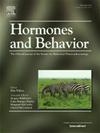Brain transcriptomics of a social challenge and maternal aggression in incubating female tree swallows
IF 2.4
3区 医学
Q2 BEHAVIORAL SCIENCES
引用次数: 0
Abstract
Aggressive behavior is ubiquitous across many contexts, including defense of territories, mates, and offspring. For decades, researchers have detailed the effect of aggressive behavior on physiology, but our understanding of these mechanisms in females lags behind that of males, despite the fact that female aggression is widespread, particularly in the context of maternal defense of eggs or offspring (i.e., maternal aggression). Here, we measured effects of a social challenge on brain gene expression in free-living incubating females. We hypothesized that the social challenge would generate at least one of three transcriptomic effects: (1) sensitizing the brain to otherwise low levels of sex steroids, (2) changing other neuroendocrine signaling pathways associated with social behavior (e.g., dopamine), or (3) broad shifts related to metabolism or immune function. We tested these hypotheses in incubating female tree swallows (Tachycineta bicolor), exposing 10 females to a 30-min simulated territorial intrusion, which elicited maternal aggression. After this challenge, we measured neural gene expression via RNA-seq and compared gene expression to 10 unchallenged controls. We saw no global treatment effect on gene expression. However, within the experimental group, more maternal aggression was correlated with upregulation of genes associated with immune activation and downregulation of genes associated with synaptic plasticity. Though more research is needed to understand the downstream effects of these transcriptional differences, our findings generate key questions about how the brain responds to social challenges across different contexts.
社会挑战和母性攻击在雌性树燕孵化中的脑转录组学研究。
攻击性行为在很多情况下都是普遍存在的,包括保卫领土、配偶和后代。几十年来,研究人员已经详细研究了攻击行为对生理的影响,但我们对雌性攻击机制的理解落后于雄性,尽管事实上雌性攻击很普遍,特别是在雌性保护卵子或后代(即母体攻击)的背景下。在这里,我们测量了社会挑战对自由生活的孵化雌性大脑基因表达的影响。我们假设社会挑战将至少产生以下三种转录组效应中的一种:(1)使大脑对低水平的性类固醇敏感,(2)改变与社会行为相关的其他神经内分泌信号通路(例如多巴胺),或(3)与代谢或免疫功能相关的广泛转变。我们在孵化中的雌性树燕(Tachycineta bicolor)中验证了这些假设,将10只雌性树燕暴露在30分钟的模拟领土入侵中,这引发了母亲的攻击。在挑战之后,我们通过RNA-seq测量神经基因表达,并将基因表达与10个未挑战的对照组进行比较。我们没有看到对基因表达的整体治疗效果。然而,在实验组中,更多的母性攻击与免疫激活相关基因的上调和突触可塑性相关基因的下调有关。虽然需要更多的研究来了解这些转录差异的下游影响,但我们的发现产生了关于大脑如何在不同背景下应对社会挑战的关键问题。
本文章由计算机程序翻译,如有差异,请以英文原文为准。
求助全文
约1分钟内获得全文
求助全文
来源期刊

Hormones and Behavior
医学-行为科学
CiteScore
6.70
自引率
8.60%
发文量
139
审稿时长
91 days
期刊介绍:
Hormones and Behavior publishes original research articles, reviews and special issues concerning hormone-brain-behavior relationships, broadly defined. The journal''s scope ranges from laboratory and field studies concerning neuroendocrine as well as endocrine mechanisms controlling the development or adult expression of behavior to studies concerning the environmental control and evolutionary significance of hormone-behavior relationships. The journal welcomes studies conducted on species ranging from invertebrates to mammals, including humans.
 求助内容:
求助内容: 应助结果提醒方式:
应助结果提醒方式:


